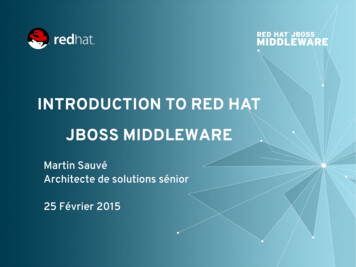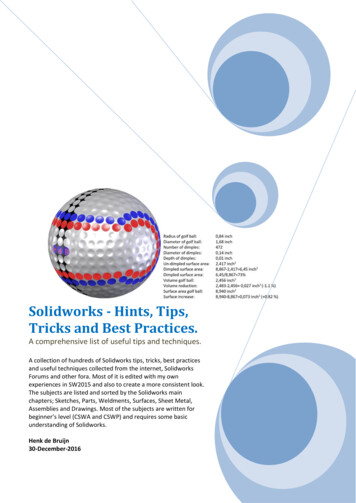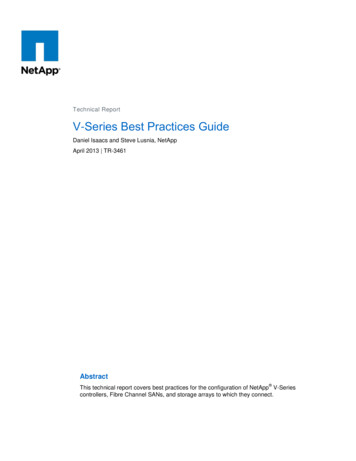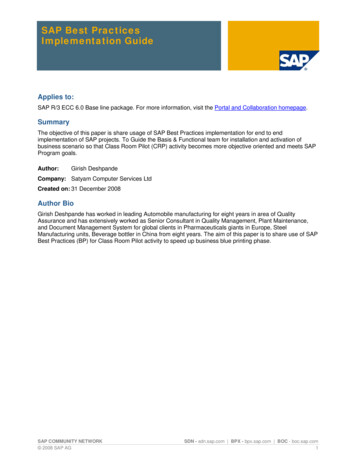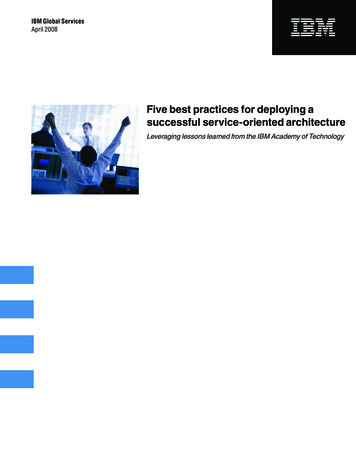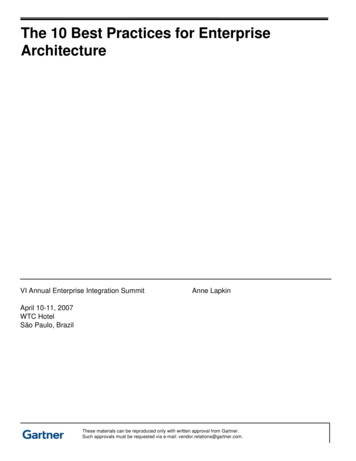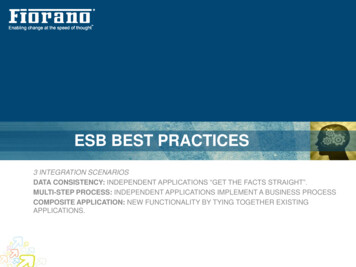
Transcription
ESB BEST PRACTICES3 INTEGRATION SCENARIOSDATA CONSISTENCY: INDEPENDENT APPLICATIONS “GET THE FACTS STRAIGHT”.MULTI-STEP PROCESS: INDEPENDENT APPLICATIONS IMPLEMENT A BUSINESS PROCESSCOMPOSITE APPLICATION: NEW FUNCTIONALITY BY TYING TOGETHER EXISTINGAPPLICATIONS.
AGENDA INTRODUCTION TO SOA DEMYSTIFYING ESB IMPLEMENTATION METHODOLOGY OF ESB STEP I – REQUIREMENTS GATHERINGSTEP II – IDENTIFYING “MUST HAVE” FEATURESSTEP III – COMPONENTIZING BUSINESS PROCESSSTEP IV – DEFINING DISTRIBUTED ESB PROCESSSTEP V – DEPLOYING ESB PROCESSSTEP VI – LAUNCHING AND MONITORING ESB PROCESSSTEP VII – CHANGE MANAGEMENT, VERSION ROLLOVERINTEGRATION SCENARIOS – PUTTING THEORY TO PRACTICE
INTRODUCTION TO SOA
INTRODUCTION TO SOAPOINT TO POINT INTEGRATION “Accidental” Architecture (Synchronous, Fine-grained, Not scalable, Many connectionsand data formats, Extremely difficult to manage, Expensive to maintain and extend) Hinders business change: new products, channels, suppliers, etc. Slow and expensive maintenance, No Reusability Expensive to Manage, Monitor and Extend Need realistic way to evolve new infrastructure and add value
BUSINESS PROCESSES BECOME AGILEWHEN IMPLEMENTED AS SERVICESBusiness Perspectives– Simplification– Elimination– People– Process PerformanceMeasurement– Simulation modeling– Agility– etc.Systems Perspectives– Working Software– Reliability– Configuration Management– Scalability / Performance– Reusability– Speed of Delivery– etc.With SOA – Processes Can Be Layered on Top of Existing Infrastructure
INTRODUCTION TO SOA – MOMCHALLENGES Easy Inter-Operability Easy Common Data Model forintegration Robust Process Management Scalability and High-Availability Distributed services management –Real time configuration changes Reusability of Components & Servicesin an effective IDE Portable Adapters Cost, Speed, Quality & Control
THE INTEGRATION BROKER ICEBERG
INTRODUCTION TO SOA - WEB SERVICESCHALLENGES Suffer from incomplete and competing standards definition that might not ensure easyinteroperability across different implementationInteroperabilty SOAP Only binding for HTTP; no bindings for SMTP, JMS “SOAP encoding”: XML Objects RosettaNet, EDIINT: no SOAP SOAP 1.1 1.2 (W3C)WSDL: RPC/Encoded vs. Document/LiteralDo not offer a complete package but provide only the functionality of access and invocationleaving majority of the development work to the userBusiness Semantics - Orchestration & ChoreographySecurity HTTPS is not enough No agreement regarding attachments S/MIME in RosettaNet and EDIINT Single SignonTransactional IntegrityReliable Asynchronous Message Handling WS-Reliability (IBM, MS) vs. WS-ReliableMessaging (OASIS)Transformation Services
DEMYSTIFYING ESB
DEMYSTIFYING ESBEnterprise Service Bus evolved out of SOA IT Components can be accessed as services Defined form of invocation and entry points to service Business process - Event-driven/Asycnhronous Inovcation of Services Composite Application – mix of existing and new components
FUNDAMENTALS OF SOA FOR INTEGRATION
DEMYSTIFYING ESBDefinition (An Affordable EAI) ?An ESB is a standards-based, service-oriented backbone capable ofconnecting hunders of application endpoints. ESBs combine messaging, WebServices, XML, data transformation and management to reliably connect andcoordinate application interaction. The ESB deployment model is an integratednetwork of collaborating service nodes, deployed in service containers.
DEMYSTIFYING ESBEnterprise Service Bus – Standards based Integration Communication and data routing (JMS) Data protocols (XML) Transformation (XSLT) Content Based Routing (CBR) Connectivity (JCA) WebServices Security Business Process Management (BPM) Pre-built Business Components Business Process Modelling (BPEL) B2B – trading partner management
WHY STANDARDS FOR INTEGRATION?BUSINESS AND TECHNOLOGY DRIVERS Increases ability to integrate No platform or vendor technology dependenciesLowers cost of integration Minimizes need for expensive proprietary adapters Larger talent pool, broader education offeringsIntegration projects become more predictable
STANDARDS-BASED INTEGRATIONBACKBONE OF STANDARDS BASED INTEGRATION Deploying a Service-Oriented Architecture (SOA)Use of XMLRise of JMS as the de-facto for underlying communication mechanismBPEL for business processConnections to Packaged Apps, Legacy Systems using J2EE ConnectorArchitecture (JCA)Web Services
SERVICE-ORIENTED ARCHITECTURE (SOA)FLEXIBLE, EXTENSIBLE INTEGRATION Design methodology for distributed systemsApplications expose functionality through service interfacesLoosely-CoupledPlatform and language neutralImpervious to implementation changesCoarse-Grained- business level InterfacesAsynchronousNo single points of failure
DEMYSTIFYING ESB
DEMYSTIFYING ESB
EXAMPLE: BUILD ON EXISTINGINFRASTRUCTUREBusiness Needs Want to replace Broker and MQdue to high TCO and complexity Reduce cost of new distributioncenters, with guaranteedmessaging Need web-service access todata Need orchestration of services Integrate new applicationsfaster and cheaper
EXAMPLE: BUILD ON EXISTINGINFRASTRUCTURESolution Services Oriented Integration Reuse messages/events withexisting MQ Incrementally add transformation,orchestration, distributedmanagement Gain immediate value from higherROI projects
DEMYSTIFYING ESBESB’s best suited for Projects that will mix heterogeneous application servers (for example,Microsoft or Java portals with disparate Java or Microsoft server backends) Enterprises who want to start with a basic SOA and add other featureslater. Enterprises that want to assemble their own best-of-breed comprehensiveintegration suites Mix and match off-the-shelf adapters, BPM, B2B and BAM tools from othervendors. Distributed services (different programming languages) running ondisparate nodes
DEMYSTIFYING ESBTypes of ESB1. ESBs based solely on SOAP -Webservices brokers (WSBs)2. Multiprotocol ESBs that support Webservices and other communicationmechanismsSource: Gartner, Who’s who in middleware, 1Q04
ESB - VENDORSSupport SOAP/HTTP and additional protocols guaranteed delivery, publishand-subscribe often following the JMS standard Fiorano ESB Sonic ESB PolarLake Iona Artix EntireX IBM's Services Integration Bus (a future e.do?command viewArticleBasic&articleId 101747
IMPLEMENTATION METHODOLOGY OF ESB
3 BASIC INTEGRATION PATTERNS
STEP 1 – REQUIREMENTS GATHERINGDATA CONSISTENCY – DATABASE SYNCHRONIZATIONThe technical requirements of ABC Corporation can be summarized as Data needs to be replicated across multiple data centers in asynchronous fashion using a Message Bus. Any changes made to the Oracle Database instance in Geneva needs to be reflected (based on aselection criteria) in either the Sybase database instance or the MSSQL database instance located in SanFrancisco and St.Louis respectively. The data needs to be transformed from the source table data format to target table data format(s). All data transfers need to be secure
STEP 1 – REQUIREMENTS GATHERINGMULTI STEP PROCESS – ORDER FULFILLMENTCompany X runs an online market place for electronics product. Orders are accepted over weband are saved in Oracle DB. For processing an order, the company needs to perform credit-cardverification using a 3’rd party hosted credit card gateway and then send out orders to suppliersover email. The supplier sends back acceptance or rejection of the order (along with expecteddelivery schedule) by a return email. This information needs to be updated in the Oracle DB, sothat customer can track the status of his order using online means.
STEP 1 – REQUIREMENTS GATHERINGCOMPOSITE APPLICATION – QUOTE TO BINDEnd to End business process for opening a new insurance policy that includes Capture ofcustomer information, Evaluation of risk of requestor, Process the Application, Develop a PriceQuote, Send Response (Quote)
STEP 1 – REQUIREMENTS GATHERINGBUSINESS – DATA SYNCHRONIZATION Data synchronization for Disaster recovery planning and businesscontinuance, Content distribution, Backup consolidation, Server migration.Completely eliminate all manual data synchronization without having to stopthe system to accommodate new outlets or changes to the tables in thesource or target systemsBusiness process monitoring Dash BoardAdd new retail outletsBusiness users should be able to orchestrate business processesTimelines – ASAPReduce development, maintenance cost
STEP 1 – REQUIREMENTS GATHERINGTECHNICAL/SYSTEMS – DATA SYNCHRONIZATION TECHNICAL High Level Business process representation – see figure shown earlier Databases (SQL, Oracle, DB2 and files) across disparate OS. Data flow representation Intended users – Business Analyst (Orchestration and Execution) System Administrator (setup, configuration, data transformation) SYSTEM Platforms and Operating Systems Overall network topology
STEP 1 – REQUIREMENTS GATHERINGOUTPUT DOCUMENTS HL Design documents that addresses the integration requirements (business &technical)Document all the identified data and process flows.List of different networks, and the servers available in each of this networkRecommended hardware specifications for the specific ESB productAny 3rd party software that is essential to the functioning of ESB
STEP 2 – INDENTIFYING “MUST HAVE” FEATURESDATA CONSISTENCY Architecture SOA ? (Hub & Spoke, Peer to Peer, Brokered Peer to Peer) Brokered P2P with store and forward at end points of the network Automatic reconnectsSupported Standards XML, JCA, CBRMessage Bus (Asynchronous, Transformation etc) Asynchronous, Transformation (at source or destination)Support for Distributed Applications (Compose, Execute and Monitor distributedApps) Location and Technology transparency, Intelligent routing, Single point ofcontrol, Deployment supportConnectivity services ( Web services,J2EE Connectors, JMS, WebSphere MQ) JMS, Database Connectivity (JDBC)
STEP 2 – INDENTIFYING “MUST HAVE” FEATURESDATA CONSISTENCY Administration / Deployment Single point of control Dynamic changes Single point of control Remote access capability Start / stop facilities Manual routing support Tracing Message editingMonitoring Problem determination Problem prediction Internal and external support Support for enterprise management frameworks
STEP 2 – INDENTIFYING “MUST HAVE” FEATURESDATA CONSISTENCY Robustness (Service and the Infrastructure level) Fault avoidance Fault toleranceScalability and Performance (Service and the Infrastructure level) Asynchronous messaging Multi-threading Load balancing Large data handlingSecurity (Infrastructure and Application level) Access control Information security Tools usage
STEP 2 – INDENTIFYING “MUST HAVE” FEATURESDATA CONSISTENCY Breadth of Connectivity (Configure, Modify, Connect with other Adapters) DBMS access (Oracle, SQL, DB2 etc) Legacy systems (Mainframe Applications) Application servers .NET COM / CORBA - Multi-Language Adapters WebServices (Publisher and Consumer)Tools Configuration (Business Processes, Services, Infrastructure) Incremental deployment Life cycle support
STEP 3 – COMPONENTIZING BUSINESSPROCESSES Component/Service/Business Service – definitionFain Grained Components - IssuesCoarse Grained Components – AdvantagesESBs and ComponentsPre-built ComponentsUser Defined Components – Best practicesReusing existing resources
STEP 3 – COMPONENTIZING BUSINESSPROCESSESFINE GRAINED COMPONENTS - ISSUES Typically represent function call (static input and outputs)Low reusability (impossible to build a general purpose Database Adapter)Development overheads (tight coupling between client and component)Change of service functionality needs re-coding ( Static data formats forinput and output)Does not lend well to business process compositionSynchronous invocation of function callsSkilled developers needed to use these components
STEP 3 – COMPONENTIZING BUSINESSPROCESSESCOARSE GRAINED COMPONENTS - ADVANTAGES Represents a high level business componentOrchestrate business processes using these componentsReusable across business process (changes only in the design timeproperties)Dynamic data formats for input and outputSynchronous & Asynchronous invocationLow development cost (middleware is hidden)Business Analyst can orchestrate business processes
STEP 3 – COMPONENTIZING BUSINESS PROCESSESENTERPRISE SERVICES - REUSABLE, BUSINESS LEVEL BUILDINGBLOCKS Coarse-Grained Level of abstraction easily understood by business peopleEvent-Enabled Interfaces Easily composed into Event ProcessesMulti-Language No development restrictionsGeneralization of Web-Services Standards-based WSDL interfaces
STEP 3 – COMPONENTIZING BUSINESSPROCESSESSERVICE INTERFACE
STEP 3 – COMPONENTIZING BUSINESSPROCESSESCOARSE GRAINED COMPONENTS“A component is a non-trivial, nearly independent, and replaceable part of asystem that fulfills a clear function in the context of a well-defined architecture.A component conforms to and provides the physical realization of a set ofinterfaces."- Philippe Krutchen, Rational Software Well defined interfaces & contracts Provides implementation of interfaces Coarse grained functionality
STEP 3 – COMPONENTIZING BUSINESSPROCESSESCOARSE GRAINED COMPONENTS"A software component is a unit of composition with contextually specifiedinterfaces and explicit context dependencies only. A software component canbe deployed independently and is subject to third-party composition."- Clemens Szyperski, Component Software Developed, tested and deployed in complete isolation Can be configured for different environment during deployment Supports contextual dependencies.
STEP 3 – COMPONENTIZING BUSINESSPROCESSESCOARSE GRAINED COMPONENTS"A component is a physical and replaceable part of a system that conforms toand provides the realization of a set of interfaces.typically represents thephysical packaging of otherwise logical elements, such as classes, interfaces,and collaborations."- Grady Booch, Jim Rumbaugh, Ivar Jacobson Includes physical packaging of files, executables, jars, dlls etc. Aggregation of classes & functions into 1 complete functionality. Higher level of reusability than Classes
STEP 3 – COMPONENTIZING BUSINESSPROCESSESPRE-BUILT SERVICES Services Bridges Database/File Adapters Web/WebServiceAdapters Routing (flow services) Transformation Signing, encryption,encoding ServicesAdapters Middleware Application
STEP 3 – COMPONENTIZING BUSINESSPROCESSESUSER DEFINED – BEST PRACTICES Identifying set of user defined servicesChoosing Appropriate programming language(Java, C, C , C#, VB, ActiveX, Perl, Python, JavaScript etc)Identifying input and output ports(dynamic or static)Custom Property Sheet(Design & runtime properties)Exception and Error Handling mechanismsTracing and Logging support Trace Modules and trace levelsLogging detailsTransaction support LocalGlobal
STEP 3 – COMPONENTIZING BUSINESSPROCESSESUSER DEFINED – BEST PRACTICES Custom Property Sheet (Design & runtime properties)
STEP 3 – COMPONENTIZING BUSINESSPROCESSESUSER DEFINED – BEST PRACTICES Identifying input and output ports (dynamic or static)Data format definitions (XSD, DTD, XML)
STEP 3 – COMPONENTIZING BUSINESSPROCESSESUSER DEFINED – BEST PRACTICES Exception and Error Handling mechanisms
STEP 3 – COMPONENTIZING BUSINESSPROCESSESUSER DEFINED – BEST PRACTICES Tracing and Logging support Trace Modules and trace levelsLogging details
STEP 3 – COMPONENTIZING BUSINESSPROCESSESUSER DEFINED – BEST PRACTICES Transaction support Local (Client level transactions) Global (XA) Compensation transactionsPerformance Requirements Expected transaction throughput Multi-threading supportSynchronous/Asynchronous
STEP 3 – COMPONENTIZING BUSINESSPROCESSESUSER DEFINED – BEST PRACTICES Tools for service developmentIDE plug-ins
STEP 3 – COMPONENTIZING BUSINESSPROCESSESREUSING EXISTING SERVICES – BEST PRACTICES Wrap existing code (Java, C, C , VB etc)Adapters to COM, DCOM, EJB, CORBA, RMI etcReusing business processes
STEP 4 – DEFINING DISTRIBUTED ESB PROCESS Control vs. Data FlowBusiness Process OrchestrationEvent WarehousingSecurityLogging, Tracing & AlertsData format impedance mismatchConfiguring Business process for failoverConfiguring Business process for performance
STEP 4 – DEFINING DISTRIBUTED ESB PROCESSCONTROL VS DATA FLOW Control Flow
STEP 4 – DEFINING DISTRIBUTED ESB PROCESSCONTROL VS DATA FLOW Data Flow
STEP 4 – DEFINING DISTRIBUTED ESB PROCESSBUSINESS PROCESS ORCHESTRATION Composition using pre-built servicesData routingControl informationData transformationIdentifying Node NamesConfiguring Service Design time properties
STEP 4 – DEFINING DISTRIBUTED ESB PROCESSEVENT WAREHOUSING Enable at runtime
STEP 4 – DEFINING DISTRIBUTED ESB PROCESSSECURITYSecurity (Role based Security)
STEP 4 – DEFINING DISTRIBUTED ESB PROCESSLOGGING, TRACING & ALERTS
STEP 4 – DEFINING DISTRIBUTED ESB PROCESSDATA FORMAT IMPEDANCE MISMATCH
STEP 4 – DEFINING DISTRIBUTED ESB PROCESSCONFIGURING BUSINESS PROCESS FOR FAILOVER Multiple node names for ServicesState failover for servicesServer level failover
STEP 4 – DEFINING DISTRIBUTED ESB PROCESSCONFIGURING BUSINESS PROCESS FOR PERFORMANCE Identifying Parallel data flowsDynamic rerouting of data based on loadIdentifying Heavy weight services (80/20 Rule)Running multiple instances of “heavy weight” services on different nodesSub-Flows and Sub-Processes for effective BP representationsLog/Trace level optimizationEvent tracing optimization
STEP 4 – DEFINING DISTRIBUTED ESB PROCESSCONFIGURING BUSINESS PROCESS FOR PERFORMANCE Service level Load Balancing (static/Dynamic)
STEP 5 – DEPLOYING ESB PROCESS Deployment - what does it mean ?Identifying Network Domain/TopologyManual Services vs. Auto-Launched ServicesSecurity issues for DeploymentService Development Languages and Platforms
STEP 5 – DEPLOYING ESB PROCESSWHAT DOES IT MEAN? Deployment Descriptor
STEP 5 – DEPLOYING ESB PROCESSWHAT DOES IT MEAN? Remote Deployment of Service and its dependenciesRemote installation of service dependenciesCaching
STEP 5 – DEPLOYING ESB PROCESSWHAT DOES IT MEAN? Managing Dependencies / Order of installation /Order of Launch
STEP 5 – DEPLOYING ESB PROCESSIDENTIFYING NETWORK DOMAIN/TOPOLOGY Deployment Domain/Nodes
STEP 5 – DEPLOYING ESB PROCESSIDENTIFYING NETWORK DOMAIN/TOPOLOGY Domain/Node Name Alias (Hierarchical Domains)Configuration Alias
STEP 5 – DEPLOYING ESB PROCESSMANUAL VS AUTO LAUNCHManual Services Executed externally to the ESB (Servlets, EJBs etc) Combination of managed and unmanaged components Managed Components like: A Webservice deployed in a Webservice container An EJB deployed in J2EE container A COM Object deployed in COM server A CORBA based server Object deployed in an ORB Windows NT/2K Service Unmanaged Components like: Java executable archive A C/C executable Legacy Application running in a mainframe environment. A Unix shell program (functioning within a pipe-and-filter stylearchitecture).
STEP 5 – DEPLOYING ESB PROCESSMANUAL VS AUTO LAUNCHAuto Launched Services Native ESB services- managed and launched by ESB containers Auto start/stop and restart of these services Connectivity management Fain grained monitoring
STEP 5 – DEPLOYING ESB PROCESSSECURITY ISSUES Deployment Manager to restrict service deployment
STEP 6 – LAUNCHING & MONITORING ESBPROCESS Remote Launch of Business ProcessMonitoring state of Application and all its associated service instancesRuntime hooks to determine state of serviceReal-time data debuggingBusiness Process Monitoring SNMP, JMX etc Monitoring of Servers
STEP 6 – LAUNCHING & MONITORING ESBPROCESSLaunch of ESB process Remote Launch of ESB Services Service Instantiation On-demand/On-Event Instantiation Auto Instantiation Re-Launch of Business Process Auto re-launch on different set of nodes Rules based re-launch of business process
STEP 6 – LAUNCHING & MONITORING ESBPROCESSMonitoring state of Application and all its associated service instances Local Queue Monitoring and Management Identify performance/scalability bottlenecks in Application Identify parallel flows in Application
STEP 6 – LAUNCHING & MONITORING ESBPROCESSRuntime hooks to determine state of service Runtime tracing and Logging Sub-Flows to handle Error conditions Alert Handlers
STEP 6 – LAUNCHING & MONITORING ESBPROCESSReal-time data debugging
STEP 6 – LAUNCHING & MONITORING ESBPROCESSBusiness Process Monitoring SNMP, JMX etc Monitoring of Servers
STEP 6 – CHANGE MANAGEMENT & VERSIONING Dynamic Extensions to Business process Static vs. Dynamic Impact Analysis Extend Business process to include new services Extend Business process to include data services with different dataformats Optimize Business process for performance, scalability Extend Business processes to handle network configuration changesDynamic changes to Business processService and Application Versioning
STEP 6 – CHANGE MANAGEMENT & VERSIONING Configuration Management Moving from one stage to another (QA to Deployment) Moving from one environment to another (customer to internal testing)Extension to Business process Updating Data Consistency Application to include the data center in SanFranciscoChange to Business Process Flexibility to adapt to new technologies (WebService instead of a C stand alone Application)
STEP 6 – CHANGE MANAGEMENT & VERSIONINGService and Application Versioning Manage and maintain multiple versions of services along with Labels Quickly allow migration from one service version to another
STEP 6 – CHANGE MANAGEMENT & VERSIONINGConfiguration Management Moving from one stage to another (QA to Deployment) Moving from one environment to another (internal to client deployment)
PUTTING THEORY TO PRACTICE
TECHNOLOGY HYPE IS CONFUSING THE ISSUES WITHOUTPROVIDING A CLEAR PATH FORWARD Need to choose standards that work today and will evolve for futureSolve the real integration problem – more than a Proof of ConceptsMust build incrementally on top of existing systems
STANDARDS REDUCE COSTS BUT FUNDAMENTAL PROBLEMS REMAIN! Business Person’s View High-level model of business process flowIT Level View Implementation flow differs substantially from business process viewImpedance mismatch creates fundamental problems Implementations have too many “moving parts” Business-level change requirements difficult and time-consuming toimplement
THE FUNDAMENTAL PROBLEM –DIVERGENT BUSINESS TECHNOLOGY
A CHANGE IN BUSINESS PROCESS
IS NOT EASILYMAPPED TO IMPLEMENTATION LEVEL
FIORANO ESBSECOND GENERATION ESB
THANK YOU!FOR MORE DETAILS, VISIT www.fiorano.com
ESB’s best suited for Projects that will mix heterogeneous application servers (for example, Microsoft or Java portals with disparate Java or Microsoft server back ends) Enterprises who want to start with a basic SOA and add other features later. Enterprises that want to assemble their own
